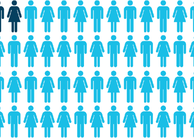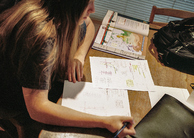Graphic Novels: Preparing for a Mulitmodal and Multiliterate WorldMultiliteracy in EducationFollowing decades of controversy, comics eventually began to gain acceptance by educators and child specialists in the 1970’s, but were relegated to the position of “last defence against illiteracy” (Gravett, 2005; Groensteen, 2000). In today’s multilingual and multicultural classrooms, especially those with little access to technology, I argue that graphic novels may instead be a first offence against illiteracy. Rather than using comics as a means to gear students towards full-length novels containing “real literature,” however, graphic novels may be used as a means towards diversifying print based literature to encompass the plurality of texts that circulate in our increasingly globalized society (New London Group, 1996) while at the same time, voicing the perspectives of a wide range of artists and writers who are not represented in traditional literature. Reading graphic novels, especially for those who have never read a comic book before, may be more challenging than expected. “The ability to ‘read’ images that portray character, mood, and tone must be developed through experience” (Goldsmith, 2002, as cited in Christensen, 2006, p. 227). While there are no rules as to how text and image, or graphic text, should be read together, Gravett (2005) states, “in some combination you read words and pictures in tandem and in cross reference, one informing the other” (p. 11). The print and graphic text appear and should be read together, but this does not always mean that they are necessarily synthesized. Though the images do often contextualize the print, they are not always illustrative of the print, but may rather, “comprise a separate narrative thread that moves forward in time in a different way than the prose text” (Chute & DeKoven, 2006, p. 769). As mentioned earlier, Cromer and Clark (2007) point out four crucial notions for interacting with the polysemic texts in graphic novels – time, intertextuality, visual literacy and hypertextuality – all of which, they claim, students can quickly learn to read with ease. First, Cromer and Clark state that readers of graphic novels need to spend considerable time interacting with the texts. Students may need to be encouraged to slow down their reading of the texts, especially the visual text, requiring teachers “to find the space in the crowded school day where this can be allowed to happen” (p. 579). Next, it is essential to recognize the intertextuality of the narratives – “the overlapping and interaction of multiple texts or voices comprising a text” (Danzak, 2011, p. 189). Yet it is equally important to understand that they are co-dependent, with each layer of graphic or print text equally necessary to meaning making (Cromer & Clark, 2007). There is also a link between each image, which leaves no part of the text in isolation. Following this, Cromer and Clark state that it is essential for a reader to be able to “read across the spaces [in and between the paneling] and provide a context that is not made explicit” (p. 580). In this way, McCloud (1993) claims, the artist and the reader are complicit with each other in creating the meaning. Goldsmith (2002, as cited in Cromer & Clark, 2007) elaborates on this stating that students must, “decode facial and body expressions, the symbolic meanings of certain images and postures, metaphors, and similes, and other social and literary nuances” (p. 580). Finally, the authors discuss the freedom that readers of graphic novels have to move beyond the conventional configuration of words on a page and read the panels on each page in any order, as they gain experience with the text format (2007, p. 581). This lack of structure, according to Cromer and Clark, “also assists student readers toward a greater comfort with open-endedness and a greater tolerance of ambiguity, when they are encouraged to recognize that readers will construct varied meanings from such hypertext-like configurations” (p. 581).This ambiguity is what marks online reading as different from most print-based reading. While most print-based texts are meant to be read from beginning to end, many guided by “[their] own disembodied, authoritative voice from nowhere” (Morgan & Andrews, 1999, as cited in Cromer & Clark, 2007, p. 582), the Internet has changed the way all of us, from students to scholars, read and process information (Cull, 2011). According to Cull, “online digital text represents a revolution in human learning and communication that we are only beginning to understand” (para. 3). Not only is online reading more cognitively complex (Cull, 2011), but we must now question each source more rigorously than in the past, no longer taking for granted the authoritative, published voice of the author. Graphic Novels and Critical Literacy in PracticeAlong with society’s changing literacy practices, the social make up of our classrooms is also changing. Limiting literacy education to traditional literacy pedagogy, which restricts so many students from full participation, no longer makes sense in an environment that is becoming increasingly multilingual and multicultural. Concerned with policies regarding how best to impart literacy instruction to immigrant and minority students, Cummins (2011) questioned the interpretations of international data used to create such policies. Based on his analyses of empirical evidence from existing research reviews and meta-analyses of international research literature, Cummins articulates three propositions to promote literacy development among immigrant and minority language students. He suggests that, (a) print access and literacy engagement play a key role in promoting reading comprehension; (b) the development of bilingual students’ L1 [first language] proficiency plays a positive role in L2 [school language] academic development; and (c) societal power relations play a direct causal role in promoting school failure among students from subordinated communities (2011, p. 1973). Cummins (2011) included these three issues within the same review because they usually present together in actual classroom practice. I will take a closer look at how the use of graphic novels may address each of these points and encourage ELL students and reluctant readers to draw from their own experiences, perspectives and multiliteracies practice to construct meaning and participate in a critical literacy experience. Proposition 1: Print Access and Literacy Engagement Play a Key Role in Promoting Reading ComprehensionThe definition of literacy proposed by the Programme for International Student Assessment (PISA) 2000 was, “understanding, using and reflecting on written texts, in order to achieve one’s goals, to develop one’s knowledge and potential, and to participate in society (OECD, 2013). For the 2009 PISA however, a slight addition was made to include, “engaging with written texts” as part of the preconditions for achieving goals, developing knowledge and potential and engaging in society (OECD, 2013, p. 9). According to the PISA 2015 Reading Framework, engagement, in this context implies the motivation to read and is comprised of a cluster of affective and behavioural characteristics that include an interest in and enjoyment of reading, a sense of control over what one reads, involvement in the social dimension of reading, and diverse and frequent reading practices (OECD, 2013, p. 10). Cummins (2011) emphasizes the importance of engagement in his synthesis of the international research literature. Drawing on a study by Lesaux, Koda, Siegel, and Shanahan (2006), Cummins reiterates that the decoding and the comprehension of text are not the same thing. While the ability to decode text is necessary, it is “complex text-level skills that require conceptual processing, such as drawing on prior knowledge, making inferences, and resolving structural and semantic ambiguities” (2006, as cited in 2011, p. 1977) that determine comprehension. According to Furrer & Skinner (2003, as cited in Guthrie et al., 2004), however, if a student feels “alienated, apathetic, rebellious, frightened, or burned out,” or in other words, disaffected (p. 404), he or she is unlikely to be interested or engaged in the text, making it more difficult to practice the skills needed to comprehend.Continued on Next Page » Suggested Reading from Inquiries Journal
Inquiries Journal provides undergraduate and graduate students around the world a platform for the wide dissemination of academic work over a range of core disciplines. Representing the work of students from hundreds of institutions around the globe, Inquiries Journal's large database of academic articles is completely free. Learn more | Blog | Submit Latest in Education |


















